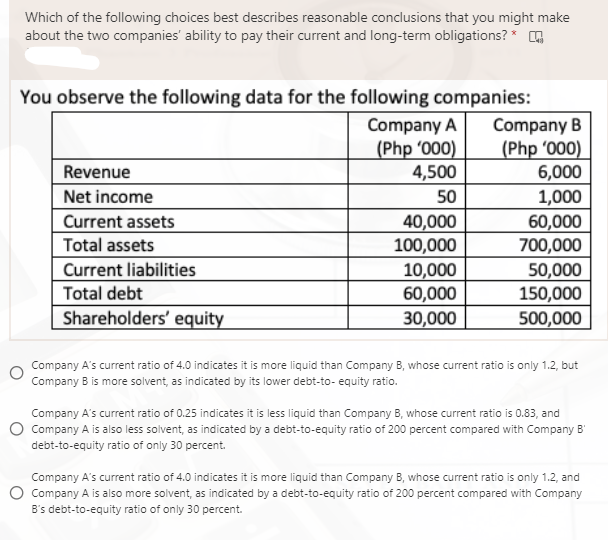Which of the following choices best describes reasonable conclusions that you might make about the two companies' ability to pay their current and long-term obligations? * Q You observe the following data for the following companies: Company A (Php '000) 4,500 Company B (Php '000) 6,000 1,000 Revenue Net income 50 40,000 100,000 60,000 700,000 Current assets Total assets Current liabilities 10,000 60,000 50,000 150,000 Total debt Shareholders' equity 30,000 500,000 Company A's current ratio of 4.0 indicates it is more liquid than Company B, whose current ratio is only 1.2, but Company B is more solvent, as indicated by its lower debt-to- equity ratio. Company A's current ratio of 0.25 indicates it is less liquid than Company B, whose current ratio is 0.83, and O Company A is also less solvent, as indicated by a debt-to-equity ratio of 200 percent compared with Company B' debt-to-equity ratio of only 30 percent. Company A's current ratio of 4.0 indicates it is more liquid than Company B, whose current ratio is only 1.2, and O Company A is also more solvent, as indicated by a debt-to-equity ratio of 200 percent compared with Company B's debt-to-equity ratio of only 30 percent.
Which of the following choices best describes reasonable conclusions that you might make about the two companies' ability to pay their current and long-term obligations? * Q You observe the following data for the following companies: Company A (Php '000) 4,500 Company B (Php '000) 6,000 1,000 Revenue Net income 50 40,000 100,000 60,000 700,000 Current assets Total assets Current liabilities 10,000 60,000 50,000 150,000 Total debt Shareholders' equity 30,000 500,000 Company A's current ratio of 4.0 indicates it is more liquid than Company B, whose current ratio is only 1.2, but Company B is more solvent, as indicated by its lower debt-to- equity ratio. Company A's current ratio of 0.25 indicates it is less liquid than Company B, whose current ratio is 0.83, and O Company A is also less solvent, as indicated by a debt-to-equity ratio of 200 percent compared with Company B' debt-to-equity ratio of only 30 percent. Company A's current ratio of 4.0 indicates it is more liquid than Company B, whose current ratio is only 1.2, and O Company A is also more solvent, as indicated by a debt-to-equity ratio of 200 percent compared with Company B's debt-to-equity ratio of only 30 percent.
Chapter9: Accounting For Receivables
Section: Chapter Questions
Problem 4TP: You are considering two possible companies for investment purposes. The following data is available...
Related questions
Question
23

Transcribed Image Text:Which of the following choices best describes reasonable conclusions that you might make
about the two companies' ability to pay their current and long-term obligations?*
You observe the following data for the following companies:
Company A
|(Php '000)
4,500
Company B
(Php '000)
6,000
1,000
Revenue
Net income
50
Current assets
40,000
100,000
60,000
700,000
Total assets
Current liabilities
10,000
60,000
50,000
150,000
Total debt
Shareholders' equity
30,000
500,000
Company A's current ratio of 4.0 indicates it is more liquid than Company B, whose current ratio is only 1.2, but
Company B is more solvent, as indicated by its lower debt-to- equity ratio.
Company A's current ratio of 0.25 indicates it is less liquid than Company B, whose current ratio is 0.83, and
Company A is also less solvent, as indicated by a debt-to-equity ratio of 200 percent compared with Company B'
debt-to-equity ratio of only 30 percent.
Company A's current ratio of 4.0 indicates it is more liquid than Company B, whose current ratio is only 1.2, and
Company A is also more solvent, as indicated by a debt-to-equity ratio of 200 percent compared with Company
B's debt-to-equity ratio of only 30 percent.
Expert Solution
This question has been solved!
Explore an expertly crafted, step-by-step solution for a thorough understanding of key concepts.
Step by step
Solved in 3 steps

Knowledge Booster
Learn more about
Need a deep-dive on the concept behind this application? Look no further. Learn more about this topic, accounting and related others by exploring similar questions and additional content below.Recommended textbooks for you

Principles of Accounting Volume 1
Accounting
ISBN:
9781947172685
Author:
OpenStax
Publisher:
OpenStax College

Cornerstones of Financial Accounting
Accounting
ISBN:
9781337690881
Author:
Jay Rich, Jeff Jones
Publisher:
Cengage Learning

Principles of Accounting Volume 1
Accounting
ISBN:
9781947172685
Author:
OpenStax
Publisher:
OpenStax College

Cornerstones of Financial Accounting
Accounting
ISBN:
9781337690881
Author:
Jay Rich, Jeff Jones
Publisher:
Cengage Learning